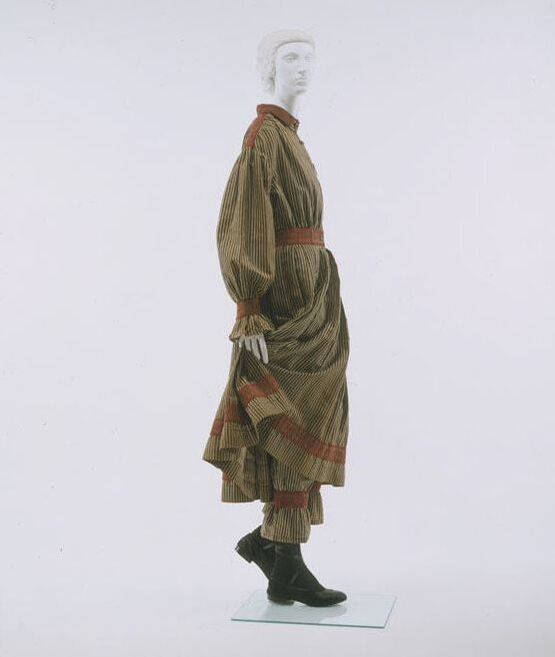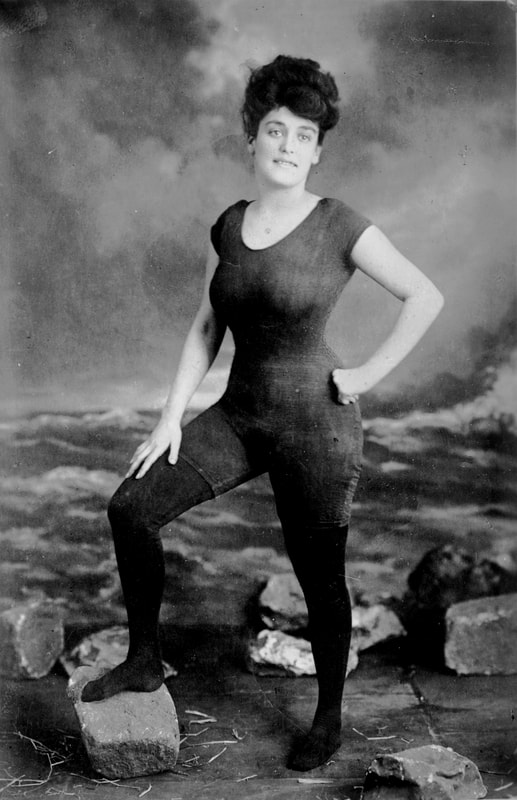|
12/9/2021 A Brief History of the SwimsuitIt’s now an industry worth more than $22 billion – but swimwear has had a long and winding road to mainstream dominance According to market and consumer data company Statista, the global swimwear market will be worth more than $29 billion by 2025. This figure is an extraordinary sum, especially considering the market was worth around $18.8 billion in 2018 and that these sums take into the account the global pandemic that wiped out much of the tourism industry in 2020 and 2021. The appeal of the swimsuit, which speaks of lithe, athletic bodies, sun-drenched beaches and time away from the hustle and bustle of our daily lives, shows no signs of abating. And, while these figures also include suits designed for sport and men’s swim shorts (which, aside from technical fabric innovations have remained largely unchanged for decades), the really interesting story are is in the rise and rise of swimwear for women. The history of the swimsuit, you see, is not merely a fashion story – but one that takes in politics, public morality and, as with so many fashion items, debates around the female body and who gets to make decisions about it. The history of the swimsuit is also the history of the rise of leisure time across the globe. Before the Industrial Revolution, time was so scarce for the average person that the thought of swimming purely for fun was laughable. The notion of a ‘holiday’ was practically unheard of. The exception to the rule was, of course, the rich and, like fashion traditions such as white wedding dresses, it is the elite classe we have to thank for the swimsuit. The first swimsuit: Bathing gowns
The bloomer swimsuitDespite its impracticality, the bathing gown remained the blueprint for women's swimwear for the next two centuries – albeit with some modification. By the mid-19th century, hemlines had raised markedly, to just below the knee, and waists became cinched but strict Victorian moral principles dictated that the high neck, sleeves, full skirts and heavy, opaque fabrics of the bathing gown would remain in place. That was, at least, until Amelia Bloomer and her scandalous eponymous garment came along. While the wide legs and high waist of the bloomer didn’t depart too significantly from the accepted version of women’s swimwear, the trouser-like construction of the leg saw them attract moral outrage. In a win for form over function, however, the bloomer swimsuit won out. By the end of the 19th Century, they were even being created in colourful cotton fabrics influenced by the growing popularity of sports across the Western world.
In 1928 Speedo introduced the racerback swimsuit which remains a mainstay of sport-focused swimwear while fabric innovations, such as the invention of nylon in 1935, also saw a dramatic change in the construction of swimsuits, making them sportier, lighter and better suited to the practical necessities of swimming. The bikini causes a splashWhen Louis Réard designed the first bikini in 1946 he knew it was going to shock the world. In fact, so explosive did he believe his design to be that he named it after the Bikini Atoll islands where nuclear experiments were taking place. While the bikini was still practical for swimming, with its bra-style top and high-cut shorts, there was no hiding behind the fact that the bikini was also very much for showing off. A descent of the nylon and latex swimsuits that had come before, the bikini was light, comfortable and perfect for warm weather – which soon saw it become a hit with LA’s glamorous stars, such as Rita Hayworth and Lauren Bacall. And once they’d given it their seal of approval, the bikini was off to the races. In fact, it wasn’t long before the bikini was outselling the one-piece and, according to data by Retviews, in 2020 the bikini accounted for 84% of global swimwear sales. Of course, in this time, designers and brands have pushed the envelope in terms of style, cut and, most importantly, fit with most brands selling bikini tops and bottoms separately to allow customers to match-and-mix their sizes as necessary. The boom in year-round travel and the relative inexpense of visiting foreign countries has also enabled the advent of specialist swimwear brands able to survive selling solely swimsuits, bikinis and their related accessories regardless of the season. Many of these, such as Heidi Klein and Norma Kamali, operate in the luxury sphere while others, including Roxy and Rixo, appeal to a younger demographic with their highly patterned styles and sportier cuts. The future of swimwearTrend forecasters predict no slowing in the growth of the swimwear market – especially given the eagerness for international travel following the shutdowns of the Covid-19 pandemic. However, WGSN does suggest a shift in style preferences towards designs suitable for both urban pools and beach resorts is likely, perhaps reflecting customers’ desire for styles that can be worn both on holiday and during trips to city lidos and hotels. However, women’s swimwear does still remain a contentious moral topic. Many an eye roll has been given to the skimpy thong bikinis and cutaway swimsuits designed to show under- and side-boob worn by contestants on television shows such as Love Island and Too Hot To Handle – whose throwaway, fast fashion construction also raise questions about sustainability and workers rights. Meanwhile, France’s 2016 ban on the ‘burkini’, which has resulted in women being fined or forced to remove clothing worn for religious reasons, also demonstrates a swing in the opposite direction and has seen the French government accused of using women’s bodies as a site for implementing Islamophobic policies. These suits do, after all, strongly resemble early swimming dresses and cover no more skin than a wetsuit and swimming cap. |
Search by typing & pressing enter








